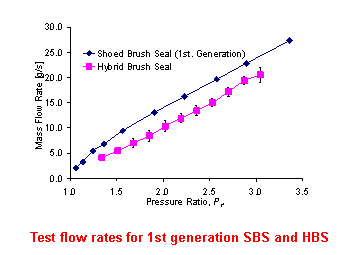Shoed Brush Seals to Improve Gas Turbine
Efficiency
Hybrid Brush Seals with
Reverse Rotation Ability
MAJOR APPLICATION: Gas Turbines, Steam Turbines
Sponsors: Turbomachinery Research Consortium (04-05), Advanced Turbomachinery
Solutions-US-NAVY SBIR II (02-03), Siemens Power Generation (2006-2008)
Objective: Measurements of leakage, power loss and structural parameters in hybrid brush seals for gas turbine and steam turbine applications
Status: Rotating test rig constructed for shaker load measurements. Leakage vs. supply pressure tests at increasing rotor speeds completed. Hybrid brush seals offer markedly low leakages and reduced power losses as pressure supply increases with little detrimental effect from rotor speed.
Hardware from Advanced
Turbomachinery Solutions (ATS)
Presentation at STLE 64th
Annual Meeting & Exhibition:
|
Comparison of leakage
performance in three types of gas annular seals operating at high temperature, Luis San Andrés & Zach
Ashton |
|
Sponsor Project # |
Amount |
Project |
Dates(GS support) |
|||
|
TRC 32513/1519S |
$ 38,000 |
Revamp Test Rig
for High Speed Operation |
9/01/10
8/31/11 (1) |
|||
|
Siemens 32525/3465A |
$ 67,000 |
High temperature
Brush Seal Test Rig |
10/01/07 9/30/08 (1) |
|||
|
Siemens 32525/34650 |
$ 75,993 |
Brush Seals with
Reverse Rotation |
01/01/06-09/30/07 (1) |
|||
|
ATS 32525/66260/ME |
$
79,580 |
Computational Analysis of Reverse Rotation Brush Seals |
10/15/01-03/31/03 (1) |
|||
To learn more,
order/read our PUBLICATIONS
2008
TEST RIG FACILITY

In 2008, a high
temperature test rig was completed to test improved versions of metal seals up
to 300 oC. Turbomachinery users will
benefit from a planned effort to characterize the dynamic and leakage
performance of the seal for various pressure drop and temperature conditions.
The tasks completed are:
a)
Measured
leakage flow across a HBS, SBS and labyrinth seal for increasing supply gas
pressures and temperatures
b)
Dynamic
load tests (shakers) for increasing supply gas pressures and temperatures.
c)
Identified
structural stiffness and damping coefficients. Force coefficients as functions
of excitation frequency and amplitude of whirl motion, supply temperature and
pressure, seal interference, etc.
SEE
SLIDE SHOW presented at STLE 2009 Conference
 Justification: Labyrinth seals are the primary seal type
used in gas turbines due to their simplicity, low cost and easy installation.
However, leakage through a labyrinth seal increases with operation due to
inevitable wear, thermal growth and rotor excursions. Furthermore, labyrinth
seals are poor rotordynamic elements, often producing negative effective
damping and leading to dangerous rotordynamic sub synchronous instabilities.
Brush seals effectively control leakage in air breathing engines. However, their
current state of the art limits their application to relatively low-pressure
differentials.
Justification: Labyrinth seals are the primary seal type
used in gas turbines due to their simplicity, low cost and easy installation.
However, leakage through a labyrinth seal increases with operation due to
inevitable wear, thermal growth and rotor excursions. Furthermore, labyrinth
seals are poor rotordynamic elements, often producing negative effective
damping and leading to dangerous rotordynamic sub synchronous instabilities.
Brush seals effectively control leakage in air breathing engines. However, their
current state of the art limits their application to relatively low-pressure
differentials.
Objective: To measure & predict brush seal
leakage, to measure mechanical parameters (stiffness and damping) from brush seal,
and to advance computational models for prediction of the dynamic forced
performance of shoed brush seals.
Status: Analysis and software complete. Effect of
dry-friction in bristle bed is paramount to generate enough damping enhancing
rotordynamic stability of multiple-shoed brush seals. In 2004, Test rig
constructed to perform dynamic force measurements with pressurized brush seals
and identification of brush seal structural stiffness and damping (dissipation)
coefficients. The physical parameter characterization using nonlinear methods
is in progress. IN 2008, test rig for operation at high temperature (500 F)
manufactured for measurement of seal leakage.
Prior/Current
Work: leakage, Stiffness and
Damping Coefficients of Brush Seals with Reverse Rotation Ability
Multiple-shoed brush seals represent an alternative to resolve poor
reliability resulting from bristle tip wear while also allowing for shaft
reverse rotation. The novel brush seal incorporates pads contacting the shaft;
and which under rotor spinning; lift off due to the generation of hydrodynamic
pressure. The ensuing gas film prevents intermittent contact; thus lowering the
operating temperature and thermal distortions, and even eliminating bristles
wear.
A computational model was advanced in 2003 with funding from
Advanced Technology Group through a US-NAVY SBIR grant. The brush seal model
relies on the physical characterization of the bristle bed structural stiffness
and damping coefficients. This can only be achieved through exhaustive testing
rather than complicated computational analyses.
In
2004 a test rig was constructed for identification of brush seal parameters.
The experimental work included leakage and dynamic load tests (shakers) for
increasing supply gas pressures. An identification method was developed to
determine the shoed-brush seal force response. Force coefficients are given as
a function of excitation frequency, supply temperature and pressure, etc. The
SBS energy dissipation mechanism is characterized using a dry-friction (coulomb
damping) and a loss factor (structural damping) coefficient. The total system
damping is also given in terms of an equivalent viscous damping coefficient.

In 2006 the test rig was revamped to conduct rotordynamic tests and
accommodate a hybrid brush seal (HBS- third generation shoed brush seal) also
developed by Advanced Technology Group. The leakage and dynamic performance of
this seal was also characterized and compared to results obtained for the shoed
brush seal. The HBS has better leakage and dynamic performance than the first
generation brush seal.


2006 TEST RIG FACILITY

2004
TEST RIG FACILITY

VIRTUAL TOUR
To be Included 30 sec video clip
To learn more,
order/read our PUBLICATIONS